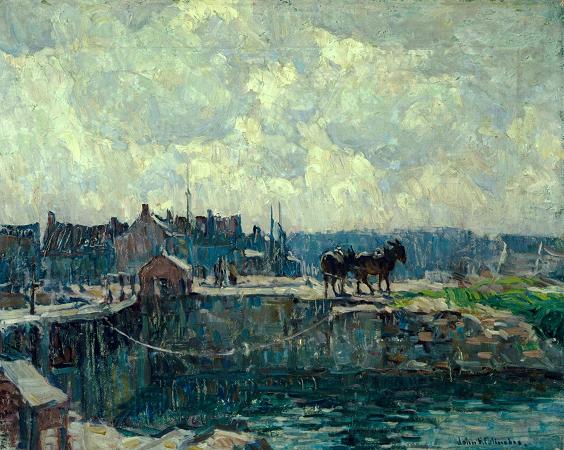John Folinsbee (1892 - 1972). John Fulton Jack Folinsbee was an American landscape, marine and portrait painter, and a member of the art colony at New Hope, Pennsylvania. He is best known today for his impressionist scenes of New Hope and Lambertville, New Jersey, particularly the factories, quarries, and canals along the Delaware River. He was born in Buffalo, New York, the middle son of Harrison and Louise Mauger Folinsbee. Beginning at age nine, he attended children's classes at the Art Students' League of Buffalo, but received his first formal training with the landscape painter Jonas Lie in 1907. Folinsbee contracted polio at age 14, which rendered his legs useless, weakened his right arm, and left him permanently wheelchair-bound. He attended The Gunnery, a boarding school in Washington, Connecticut, from 1907 to 1911, where he studied with Elizabeth Kempton and Herbert Faulkner. He later studied with Birge Harrison and John Carlson at the Woodstock art colony, and with Frank Vincent DuMond at the Art Students League of New York. At Woodstock, he met Harry Leith-Ross, who became a lifelong friend and later followed him to New Hope. In 1914, Folinsbee married Ruth Baldwin; daughter of William H. Baldwin, Jr. and Ruth Standish Baldwin; whom he had met in Washington, Connecticut. The couple moved to New Hope in 1916, and had two daughters, Elizabeth, married Elmer W. Wiggins, 1940; and Joan, married Peter G. Cook, 1938. Early in his career, Folinsbee painted in a tonalist style, with an interest in light and atmosphere that grew directly from his time with Harrison and Carlson in Woodstock. By the late nineteen-teens, he had moved away from tonalism into a more structured, impressionist style. In the mid-1920s, Folinsbee began studying the work of Cezanne, which led to a trip to France in the summer of 1926. The paintings that resulted from this trip, and those that followed later in the decade, reflect a deep understanding of Cezanne's compositional strategies and a desire to reveal the underlying structure of forms. Folinsbee's exploration of structure led eventually to an analytical, highly individual expressionist style in which he painted for the remainder of his career. His palette darkened, his brushstrokes loosened further, and his sense of light and atmosphere became more dramatic. These later works are concerned with conveying a sense of mood and an intense emotional response to the world around him. His basic aim was the communication of feeling; the subject had to be felt to be worth painting. The communication of that feeling was what a painting was all about; without that excitement in the subject, a painting was merely a dead reproduction of nature or of natural phenomena. Folinsbee painted en plein air, directly from nature. He always had a sketchbook or a box of 8 x 10 inch canvasboards with him, ready to capture any scene that caught his eye. He and Leith-Ross were famous for spending afternoons sketching on the bridge at New Hope. Folinsbee could handle paintings as large as 24 X 30 from his wheelchair. Larger works were painted in his studio from drawings and oil sketches. He frequently repeated the same scene on different sized canvases, or as an etching or lithograph. To paint a large work, he would lean a canvas against the studio wall and sit on the floor before it, his withered legs tucked under him. Relying on notes made on the spot about color and light, he would edit the scene as he painted, emphasizing or eliminating elements to enhance the overall mood. The larger studio paintings were never simply blown-up versions of a successful small painting: rather they were developments of a theme along expressive lines, with memory and emotional reaction playing an important role. The Folinsbees purchased an acre of riverfront land about a quarter-mile upstream from the bridge, across the street from the house they were renting. In 1924, they hired architect Morgan Colt to design them an Arts & Crafts-style house and studio. Folinsbee painted dozens of views of the river from the property; most notably Winter Nocturne, River Ice, and his last major work, Zero Morning; and some views of the house itself. They lived at 160 North Main Street until their deaths. In 1929, the Folinsbees were among the founders of Phillips' Mill, an arts center housed in a former grist mill, and Ruth Folinsbee served as the first vice-president of its community association. He participated in art exhibitions there from 1929 into the 1960s.
more...













